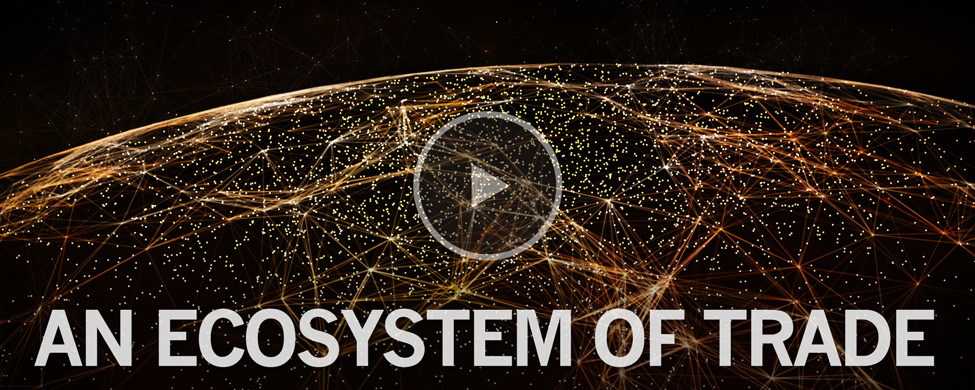What Is A World Trade Center?
A World Trade Center provides businesses with access to a diverse array of state-of-the-art international trade services and facilities, enabling them to pick and choose among the services that can help them increase their international sales. By gathering together in single space international businesses, international trade service providers, and its own in-house international trade services, WTCs create a “Critical mass” of international business expertise that attracts leading companies to the project and stimulates economic growth throughout the community.
A WTC does not attempt to compete with organizations already involved in world trade. Instead, it aims to assist them by offering a setting that permits these organizations to flourish — and to complement these organizations by offering programs and services that are not available elsewhere. Unlike other trade promotion groups, WTCs promote imports as well as exports — and all other types of international business transactions.
The prime mission of a WTC is to support the world trade objectives of the region it serves. Therefore, a WTC must necessarily reflect the business resources and business goals of that region. Thus, there is no single formula for a successful WTC. Rather, each WTC must be carefully tailored to the individual objectives, opportunities and obstacles of its own region. This applies to every aspect of a WTC, including its size, location, organization, facilities and services.
While each WTC is unique, there are two common components of a fully operational WTC:
• A physical facility with tenants, and
• Trade-related services that are offered to those tenants and to the community at large.
Within those basic parameters, some WTCs may concentrate on offering trade services to the community before launching their real estate operation. Others may begin with the real estate component and add the services later. What unites them all is their desire to serve as the focal point of international trade in their regions.
Physical Facilities
The centralized accommodation of organizations involved in trade is basic to the definition of a WTC.
Throughout civilization, every community of any size in any land has used trading centers. These were physical locations where people came to buy and sell. Over the years, they have been called by different names, including bazaars, marchés and, more recently, shopping centers. They have all served a natural need for society to trade in a central location. A WTC, of course, is a modern shopping center for traders.
By combining in one place a wide variety of world trade organizations — exporters, importers, transportation agencies, financial and insurance firms, government agencies and many more — a WTC creates a thriving center of world commerce for its region.
Many of these agencies do business with one another on a regular basis and benefit greatly from close proximity to their bank, freight forwarder or law firm, for example. Altogether, this impressive commercial array attracts many more business visitors than any of the individual organizations would expect to receive if located elsewhere. It is the shopping center phenomenon.
What is the ideal proportion of the various types of tenants in a WTC? Because a WTC seeks to represent the trading community of its region, a good approach would be to try to attract representative firms, preferably the leaders, of every sector of the region’s international business community.
World Trade Services:
The second basic requirement for a WTC is trade services. The services may be provided by the WTC’s central management group, by a WTC tenant or by another organization under contract with the WTC.
The important point is that all important trade services are available to WTC tenants, WTC members and the region’s business community in general. While there are exceptions, e.g., customized labor-intensive services, it normally is not good business practice to limit WTC services to WTC tenants or even WTC members. This is because these groups often do not represent a large enough business base to make a specific service viable. A better approach is to make the service available to the broadest business community — and to give tenants and WTC members a special discount. This approach also helps achieve the regional trade assistance goals of the WTC and attracts the regional interest and support that is important to a WTC’s success.
Here are some of the major services that a WTC should provide:
• WTCA On-Line • Research
• Trade Information Services • Office Services
• Seminars • Publications
• Trade Missions • WTC Club
• Translation
Detailed information on these services is provided later in this Handbook.
As mentioned, some of these services can be provided by WTC tenants or other organizations, but it is important that the desired level of quality is maintained. Use of another organization to provide a given service has the advantage of freeing the WTC’s central management to concentrate on other WTC functions.
About World Trade Center:
More than a building or an organization, a World Trade Center (WTC) is a thriving microcosm of the businesses, services, organizations and individuals, involved in the world of trade? A global commerce site which offers prime interactivity and exposure to the businesses driving international trade.
WTCs stimulate local, national and global economies within the framework of a virtual marketplace; a Centre-point of access and exposure critical for international trade success. “A World Trade Centre in any city is a business shopping Centre, complementing and supporting the existing services of private and government agencies,” explains World Trade Centre Association (WTCA) Founder, Guy F. Tozzoli.
Information, expertise and energy – elements essential to successful trade on a global scale – power the WTC environment, enabling immediate access to the valuable expertise that drives export of all kinds.
World Trade Centre Association (WTCA) History: The WTCA is a not-for-profit, non-political association that exists to foster the development and success of international business trade. Its membership is almost 350 WTCs in more than 110 countries. Over 750,000 companies are affiliated with WTCA members worldwide.
The WTCA was established in 1970 to facilitate international trade to offer exporters, importers and service providers a resource and commerce base. The first of these pioneer Centers were built in Houston, New Orleans, New York and Tokyo, after which the World Trade Centre Association was borne.
WTCA Mission Statement: Our mission is to support the establishment and successful operation of individual World Trade Centers as part of a worldwide alliance, enhancing the stability, peace and development of world trade and economic growth.
About World Trade Center’s Association:
Vision
We continue to build a respected and valued brand that will be represented in all parts of the world by World Trade Centers. It shall be known for the quality of its trade services and prominent facilities. The World Trade Centers will be interconnected for the successful promotion of international trade and investment.
Mission
We foster a global World Trade Center network that enhances the brand and promotes prosperity through trade and investment.
History
An Iconic Landmark is Born:
The 1939 World’s Fair in Queens, NY, named its grounds “world trade center” (Glanz & Lipton, 2003, p. 28) [1]. Under the Chairmanship of David Rockefeller, in 1959 the Downtown-Lower Manhattan Association initiated a mission to construct a permanent building to serve as the gathering place for all agencies and players of what Mr. Rockefeller saw as a coming explosion in international trade. According to Glanz and Lipton (2003), this would be a place where:
The United States and foreign business and financial interests can meet to do business; where representatives of the United States and foreign governments are available for consultation and aid; and where facilities are available to expedite business transactions.
To finance and build such a project, the Downtown-Lower Manhattan Association turned to the state agency, The Port Authority of New York and New Jersey, to review the feasibility of such a project. On March 10, 1961 the Port Authority issued a report that endorsed the feasibility of the David Rockefeller vision and justified it as a viable public project because it would serve as a catalyst for business growth, and increase employment and net revenue to the city from augmented economic activity. This conclusion did not pass without fierce opposition from other stakeholders. These were mostly the merchants in the proposed area who were to be displaced. It took a US Supreme Court decision in November 1963 to reaffirm the public purpose nature of the project before the construction of the World Trade Center could eventually begin in downtown New York City. A young man celebrating his 40th birthday on February 12, 1962 was told by his boss, Mr. Austin Tobin: “You are going to build the trade center”. That young man was Mr. Guy Tozzoli (Glanz & Lipton, 2003, p. 98).
The legal battles and public protests out of the way, Guy Tozzoli settled on Minoru Yamasaki, as the architect. After more than 100 designs, Guy and the Port Authority signed off on the Twin Towers design. In April 1973, the World Trade Center, the dream of David Rockefeller, became a reality and his brother, the then Governor of the state of New York, Nelson Rockefeller, dedicated the 120-story iconic dual structures known as the Word Trade Center. They became an instant icon around the world. The World Trade Center would also represent something else. On the 77th floor of the North Tower, it would house the headquarters of the World Trade Center’s Association.
An Association is Born:
The Rockefeller vision was not just a building but a place where international business services would be provided; communication among related businesses would be facilitated; and a supportive network would be built, all as a means of bringing value to the city. It was equally important that structures would be set up to bring these services into reality just as the towers were taking shape. The essential relationship between a prominent building and support services to promote trade was conceived from the beginning and continues today in the 40-year life of the World Trade Center’s Association. To make this happen, the Port Authority arranged a meeting in April 1968 in New Orleans. The purpose was to bring together like-minded cities in other parts of the USA and the world that saw the same benefits of the world trade center concept to consider ways to provide mutual assistance. The cities were: Amsterdam, Antwerp, New Orleans, New York, Paris, Rotterdam and Tokyo. The choice of New Orleans was in recognition of its status of operating the International House since 1945.
The goals of the group were:
• To promote international business relationships
• To encourage mutual assistance and cooperation among its members
• To foster increased participation in world trade by developing nations
The result of this vision was the creation of the World Trade Center’s Association that was incorporated in Delaware, USA on August 12, 1969 as a nonprofit organization. It was subsequently registered as a membership association under US Internal Revenue Service Code Section 501(c) 6. At its first formal meeting in Tokyo in 1970, Guy Tozzoli was elected as its volunteer leader. They agreed that the Secretariat should remain at the Port Authority of New York and New Jersey. Guy continued in his role as the volunteer leader until his retirement from the Port Authority in 1987 when he became the Association’s first and current president. The fifteen cities represented at the Tokyo meeting were: Amsterdam, Antwerp, New Orleans, New York, Paris, Rotterdam, Tokyo, Baltimore, Boston, Brussels, Houston, Le Havre, Philadelphia, and Toronto. Membership to the WTCA was on a metropolitan basis, and defined as an economic region.
The WTCA was born out of a studied need to create facilities that would serve as focal points for the convenience of the promotion of international commerce. The facilitation of commerce was recognized early; first as a form of physical interaction of various people in the chain: locally, then regionally, then internationally. Next to facility, the single most important activity was the network to deliver the international business adn trade services. Today, the 15 original members have grown to 330+ World Trade Centers in 100 countries.
The devastating events that unfolded on September 11, 2001 destroyed the physical structures that were the birthplace and the home of the World Trade Center’s Association for the first 30 years of its existence, and resulted in the senseless loss of thousands of innocent lives. Instead of retreating from international trade though, the WTCA and global commerce have continued on a path of exponential growth since September 2001. They did this as evidence of their commitment to brand themselves as a global city and to make themselves full and viable competitors in the increasingly global marketplace.
WTCA is projecting continued, measured growth in markets such as China, India and Brazil and the application of the WTC concept in cities large and small around the globe. The future looks very bright for World Trade Centers because more and more companies and communities realize that in order to be relevant and viable in the future, they must compete successfully in international markets.







